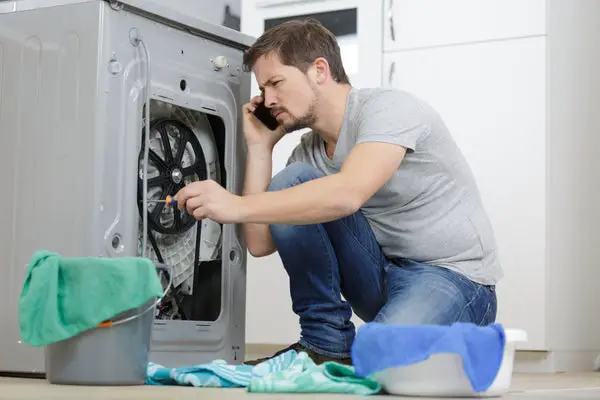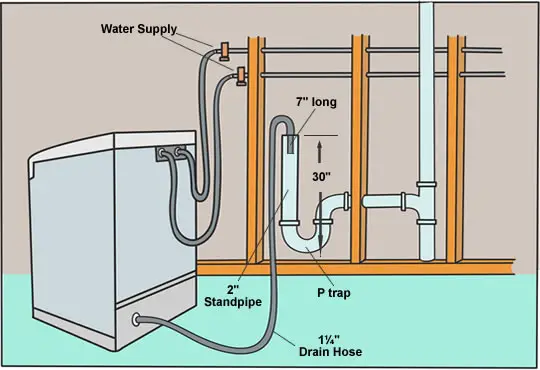The electric bill isn’t the only concern when you use a washing machine. You also need to consider the drainage options to remove the used water from the washing machine. Taking the drain hose over the sink won’t do! If drainage isn’t adequate, you will have many problems with your hands. Luckily, you have many washing machine drainage options to choose from.
Page Table of Contents
What are the most common options for washing machine drainage?

We advise you to examine the most frequent solutions to drain the washing machine before you decide. Opt for the washing machine drainage option most suited for your house and budget.
Laundry Tub
Clean water has to replace dirty water during the wash cycle. It’s how your clothes will get clean. A laundry tub is one of the most efficient washing machine drainage options. The drain hose is typically located 25 to 30 inches above the floor. You will need to place the laundry tub below 12 to 18 inches beside your washer. You don’t need to call a licensed plumber and be sure that the laundry water will drain properly.
Should the laundry tub option works for your household, we strongly recommend it!
Standpipe
If you look for the cheapest and easiest drainage options, the standpipe is the one for you. This method will save a lot of space and you only need to install a standpipe connected to the washing machine’s drainage hose. You need to do it to drain the dirty water from the washer quickly.
See that the standpipe you use has the proper diameter– 2 inches in diameter is enough for a smooth water flow. Using a stand pipe instead of attaching the washer to the drain line reduces the risk of water overflow. With the standpipe solution, you won’t deal with unpleasant fumes from the sewer.
Installing the standpipe doesn’t require professional plumbing and you only need some basic knowledge about piping. If you fear you won’t do it properly, call a plumber. It’s not an expensive service at all.
Underground Pipe Link
When you are 100% sure that you will use the washing machine in the same place for a long time, we recommend you opt for the underground pipe link. It’s one of the best washer drainage options for many households. The washing machine water will drain right to the waste stack. However, you will spend a lot of money on this drainage option as it requires extensive plumbing work.
When the underground pipe connection clogs or breaks, it will require servicing from professional plumbers. Typically, underground pipe connections are set up behind a concrete wall, so fixing requires the teardown of walls.
The drain pipe must be attached to the washing machine drain hose and pass down through the floor to push the laundry water outside the laundry room. If you’re not sure you will keep the washing machine in the same place, you shouldn’t go with the underground pipe connection.
How should you pick the drainage option?
We recommend you install the washing machine drainage option that works best for your household and budget. If your budget is tight, the standpipe and the laundry tub represent the best choices. Opt for the underground pipe link if you care a lot about the aesthetics and are willing to pay the extra buck.
The laundry tub solution is space-consuming, so it doesn’t make for the wisest choice when you’re concerned about space. The standpipe and the underground pipe connection represent the best option when space is an issue.
Last but not least, think about your plans. Do you plan to move house in the next five years? Do you like decorating your home a lot? If the answer is “yes” to any of these questions, we recommend avoiding the underground pipe link as a drainage option.
Are you interested in running the washing machine drain outside? Here’s how to do it!

If you don’t want to waste any of the drained water from the washer, draining it outside is the best option for you. You can extend the washing machine drain pipe outside the backyard to water the plants. This drainage option allows you to store the water in a septic tank for recycling it.
It makes perfect sense to wonder if using the “grey water” isn’t a health hazard, even for the irrigation network. You must get some basic information about greywater.
What is greywater?
Greywater is the used detergent water that doesn’t contain toxic elements and harmful pathogens– it’s minimally damaging the yard and plants. It’s not the “black water” that the toilet drains. Even so, some plants won’t tolerate detergents as they’re not all safe.
Having said that, we recommend you examine if the plants in your backyard are tolerant to detergents before you make the drainage system go in the yard. Venus Flytraps is one of the plants sensitive to additives and doesn’t tolerate detergent water. Ensure that it’s safe for the plants to run the washing machine drain hose outside.
Don’t take the greywater in the ground if you have flower beds, lawns, and annual vegetables. Fruit plants, edible vines, berry bushes, and significant and permanent plants will, on the other hand, benefit from it.
Additional Important Considerations
It’s essential to contain the greywater within your environment, so don’t irrigate sloped areas where runoff may cross your property lines. Always keep the greywater at ground level when watering the lawn and sprinkle it from above. You need to reduce the contact with the produce– root vegetables represent an exception.
We also recommend alternate greywater with a fresh one when irrigating to flush away the impurities.
What not to do when draining the washing machine outside
We encourage you to do due diligence before draining the washing machine outside. Some of the aspects of being aware of come down below:
Avoid detergents with sodium
If you want to drain the greywater from the washing machine outside in your planted yard, make sure you never use detergents with sodium. Sodium in plants is toxic and creates stunted plant growth, obstructed and uneven plant cell development. Always use detergents made with phosphorous for plants as they’re good for them.
Never use borax or bleach with the laundry
Never use borax or bleach with the laundry if the washing machine drainage system goes in the ground. Even if bleach is sprayed on weeds to stop their growth, it will simply kill plants when drained into the ground. Additionally, it will stop plants from growing again. Soil with bleach in it doesn’t allow plants to grow. Bleach isn’t good for the soil as it reduces its fertility.
Don’t wash clothes with feces
When you wash diapers and clothes in the washing machine, you will no longer have greywater but black water. Feces and stools contain dangerous pathogens that can poison plants and cause diseases. The problem is even more significant if you use the plants for eating.
Reduce the risk of clogging
Take all the necessary measures so that the washing machine doesn’t clog. You shouldn’t opt for this drainage solution to irrigate areas uphill or on a slope, even if you have a strong pump. The pump won’t be able to push the water. On the other hand, if the irrigation area is downhill from the washing machine, you can drain the washing machine outside.
Pay attention not to throw objects in the washing machine– they can drain away and pollute the soil. Moreover, the thing clogs the drainage pipe and stops the washing machine from drainage. Install a filter on the open end of the hose to reduce the risk of clogging.
Drain the washing machine outside- here are the steps to take!
When you consider that draining the washing machine outside the house is the adequate solution for you, we recommend you follow the steps down below:
Plan to detail
Like many things in life, you need to plan to detail draining the washing machine outside the house. Think about where you want to drain the washing machine and decide where the passage for drainage will go from.
One option is to drain the water in a barrel and use the water for your lawn in smaller bursts. It’s also possible to attach the washing machine hose to the irrigation system. Dropping the hose outside is the most straightforward option, nevertheless.
Get the tools and equipment you need
Make sure you have all the supplies, tools, pipes, and equipment for the job. Write down the list of everything you will need. When the washing machine is far from the yard, you will need a long drain pipe and extend the drain hose. If you want to use a barrel, you will need to buy one of at least 41 gallons–it’s the average water load from washing machines.
Create a routine
When you run washing machine drain house outside, you need to have a routine to wash the clothes. If the washing machine drains on the landscape, the water will impact the growth of the green landscape. Think about the times and days when your greenery needs watering and plan the washing accordingly.
Also, make sure that everything works correctly. The washer drain hose shouldn’t clog and all the pipes and hose connections should be watertight. You don’t want any leaks as they can flood your house with greywater.

